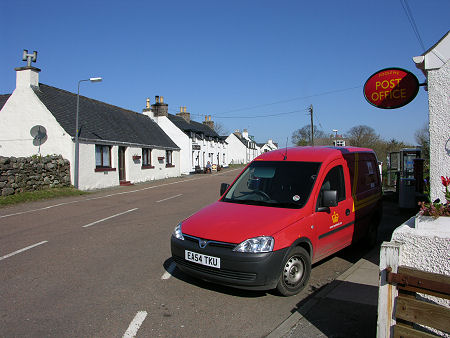 Poolewe in Wester Ross, part of what was Ross & Cromarty |
Ross and Cromarty became one of the 33 counties into which Scotland was divided for administrative purposes in 1890. A reorganisation in that year of the traditional 34 counties tidied up the map and removed enclaves and exclaves in a number of parts of Scotland.
 Ross and Cromarty, 1890 to 1975 Note About Image Copyright |
The major change, however, was the merger of the traditional county of Ross-shire with the traditional county of Cromartyshire, which had formed a series of exclaves within Ross-shire. The result was the new county of Ross and Cromarty.
Ross and Cromarty extended from the east coast around Dingwall, the county town, to the mountainous west coast: and beyond, for it also included the Isle of Lewis in the Western Isles. This must have been a been an unwieldy area to manage, but the arrangement persisted until 1975.
The area covered by the county was largely based on the traditional area of Ross. This had been one of the medieval mormaerdoms of Scotland at a time when the Norse and the Scots struggled for control of what is now northern Scotland. It later became an earldom that was much fought over between the Lords of the Isles and the Stewart Kings of Scotland.
Like Ross-shire before it, the mainland part of Ross and Cromarty was often divided for descriptive purposes into Wester Ross and Easter Ross (or "Easter Ross and Cromarty"), with the dividing line between them vague, but approximately following the watershed. Both Wester Ross and Easter Ross survive as descriptive terms in common use into the modern era.
In 1975, a major reorganisation swept all of Scotland's the counties away in favour of 12 regions. The regions formed in 1975 were the upper tier of a two tier local authority system. Most were divided into a number of district council areas, and Ross & Cromarty became one of eight district councils that delivered a range of local level services within the wider area of the newly formed Highland Region. It was bordered to its south by the districts of Inverness and Skye and Lochalsh, and to its north by the district of Sutherland. The Isle of Lewis was split off to form part of a new region called The Western Isles.
When regions and districts disappeared from the scene in the 1996 reorganisation, Ross & Cromarty became part of the unitary council area of Highland. Initially Highland Council divided its coverage into eight management areas that were closely based on the eight districts. Since 2007, Highland Council has divided up its area rather differently into three operational areas. For the council's purposes, what used to be Ross & Cromarty is now split along the old Easter/Wester Ross lines and is divided between the "Caithness, Sutherland and Easter Ross" and the "Ross, Skye and Lochaber" operational areas.

